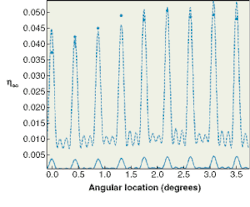Optical cavity enhances hologram efficiency
Researchers at Massachusetts Institute of Technology (MIT; Cambridge, MA) have found a way of increasing the amount of light diffracted by volume holograms without decreasing the number of holograms they can store. Known as resonant holography, the technique should improve the performance of holographic interconnects, memories, and communications systems. In experiments, the MIT team found that the M number—a parameter that relates to the amount of information that can be stored in a holographic memory—is improved by more than three times using the new method. In addition, resonant holography might be able to improve the resolution of some imaging systems.
The new technique, developed by Arnab Sinha and George Barbastathis of MIT's Department of Mechanical Engineering, involves placing the volume hologram inside an optical resonator or etalon.1, 2 Light enters the etalon through a partially reflecting mirror and the diffracted energy leaves the etalon (see Fig. 1). However, the zeroth-order or undiffracted light is reflected by a second mirror, some of which is diffracted by the hologram on its return journey. This exits the etalon in the opposite direction. In this way, undiffracted light is recycled—it is not lost unless it goes out the way it came in.
To avoid garbling of the reconstructed hologram, all the diffracting beams must interfere constructively. This resonance condition places strict requirements on both the geometry of the system—the distance between mirrors must provide an appropriate path difference between beams—and the quality of the input. In the latter case, the temporal coherence of the laser used must be high: light diffracted immediately must be coherent with light that has made many passes through the system. In addition, the reflectivity of the partially reflecting mirror must be taken into account in the resonator design.
Increased capacity
The resulting improvement in the amount of light diffracted from a given hologram is particularly important in applications in which many gratings are stored within the same volume. As they are recorded, each hologram erases some of the hologram that preceded it so—even though a single hologram for an optical element could have a diffraction efficiency of 80% or more—the efficiency of the 1000th hologram in a holographic memory will be a small fraction of a percent. The number of photons diffracted can be increased by using a more powerful laser, but the scaling of required laser power as a function of the number of holograms is quadratic—that is, one would need 100 times the laser power to increase the number of gratings stored by a factor of 10.
As a result, the number of holograms that can be stored at a single location is capped by the minimum diffraction efficiency that the system (based on the detector noise and laser power) can cope with. By making all holograms more efficient—up to 10 times more efficient in recent experiments—the resonant approach instantly multiplies the capacity of a holographic memory (see Fig. 2).
Barbastathis says that resonant holography will have applications in imaging as well as data storage. One technique that could immediately benefit is nonscanning confocal imaging—this involves using a multiplexed hologram of virtual pinholes that allows data to be captured from many voxels (volume pixels) in parallel. Resonant holography will increase the number of pixels available in the final image. In addition, says Barbastathis, they have obtained preliminary evidence that resonant holograms are also superior in terms of other performance metrics—depth resolution in ranging systems, for example.
REFERENCES
- A. Sinha and G. Barbastathis, Proc. SPIE 4789 (2002).
- A. Sinha and G. Barbastathis, Opt. Lett. 27(6) 385 (March 15, 2002).


